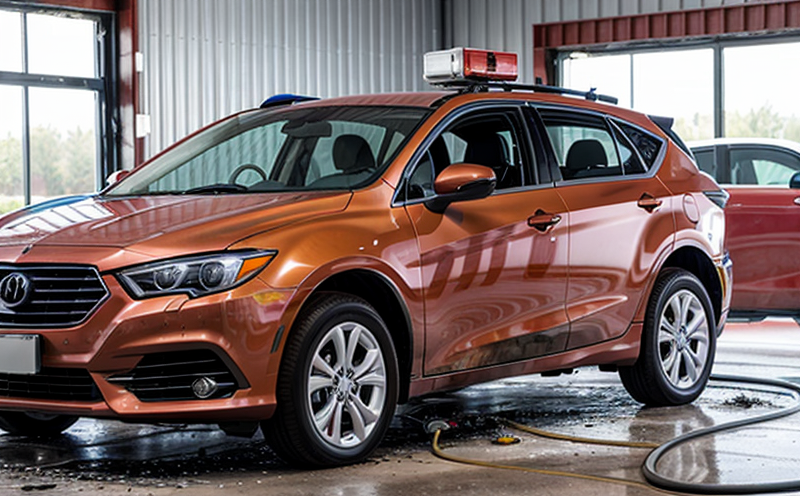Fire Performance Testing of Automotive Foams
The fire performance testing of automotive foams is a critical aspect of ensuring safety and compliance in the transportation industry. This testing evaluates how well foam materials withstand exposure to heat, flame, and other sources of ignition without compromising structural integrity or releasing harmful substances into the environment. The purpose is to identify any potential risks that could endanger passengers or compromise vehicle performance during an emergency.
Automotive foams are used in various applications such as seating cushions, door panels, and undercarpeting. These materials must meet stringent fire safety standards set by regulatory bodies like the National Fire Protection Association (NFPA) and European Union directives to ensure passenger safety. The testing process involves controlled exposure of foam samples to heat sources or flames, followed by analysis of their behavior over time.
Standard test methods for automotive foams include ISO 12450 for seating foam and ASTM D739 for open-cell polyurethane foam. These protocols specify the conditions under which tests are conducted, including temperature, duration, and type of flame or heat source used. Compliance with these standards ensures that products meet industry expectations regarding fire resistance.
During testing, samples undergo rigorous evaluation through visual inspection, mass loss measurement, char depth determination, and smoke density assessment. Results provide insights into the foam's flammability characteristics, thermal stability, and decomposition behavior. This information helps manufacturers make informed decisions about material selection and process optimization aimed at enhancing fire safety features.
Understanding the results of these tests is essential for quality managers responsible for ensuring product compliance with regulatory requirements. Compliance officers rely on accurate test outcomes to demonstrate adherence to relevant regulations during audits or inspections. R&D engineers use this information when developing new foam formulations that balance comfort, durability, and safety. Procurement professionals leverage these findings to source high-quality materials from trusted suppliers who can consistently deliver compliant products.
In summary, fire performance testing of automotive foams plays a vital role in safeguarding lives by preventing fires within vehicles and minimizing their spread if they do occur. By adhering strictly to established protocols and interpreting test results correctly, stakeholders across the industry contribute significantly towards maintaining high standards of safety and reliability in automotive manufacturing processes.
Why It Matters
The importance of fire performance testing cannot be overstated when considering its impact on public safety. Fires inside vehicles can lead to severe injuries or fatalities if occupants are exposed to toxic smoke, intense heat, or direct flames. Ensuring that automotive foams meet appropriate flammability standards helps mitigate these risks by providing a barrier between passengers and potential hazards.
Compliance with international regulations such as NFPA 1951 for fire truck seating foam or European Union Directive 2003/147/EC regarding upholstered furniture enhances consumer confidence in vehicle safety features. Meeting these requirements also protects manufacturers from legal action related to product liability claims resulting from inadequate fire protection.
From an operational perspective, successful completion of fire performance testing demonstrates a company's commitment to quality and reliability. Positive test results can enhance brand reputation among consumers who prioritize safety when making purchasing decisions. Furthermore, they facilitate smoother interactions with regulatory bodies during periodic reviews or inspections, reducing the likelihood of costly delays or penalties.
In conclusion, fire performance testing is not just a technical requirement but also an important step towards achieving peace of mind for everyone involved in automotive manufacturing and usage. It serves as a cornerstone for building trust between producers and consumers while promoting safer travel experiences worldwide.
Benefits
The benefits of conducting fire performance testing on automotive foams extend beyond mere compliance; they encompass improved product quality, enhanced safety features, reduced risks associated with fires within vehicles, increased brand reputation, and streamlined regulatory interactions. Here are some key advantages:
- Improved Product Quality: Thorough testing ensures that only the highest-quality materials are used in automotive manufacturing processes.
- Enhanced Safety Features: By identifying weak points early on during development stages, engineers can refine foam formulations to better resist fire damage and protect occupants effectively.
- Reduced Risks Associated with Fires within Vehicles: Rigorous evaluation helps prevent accidents caused by spontaneous combustion or spread of flames through seating areas or other parts containing foam materials.
- Increased Brand Reputation: Positive outcomes from fire performance tests contribute to a positive public image, fostering loyalty among customers who appreciate safety-oriented products.
- Streamlined Regulatory Interactions: Compliance with relevant standards reduces the chance of encountering regulatory barriers or facing fines due to non-conformity issues.
In summary, fire performance testing offers numerous benefits that ultimately translate into better products and happier customers across all sectors involved in automotive manufacturing. Investing time and resources into this critical aspect pays off handsomely through improved safety outcomes and enhanced market position.
Why Choose This Test
Selecting the right fire performance testing method for automotive foams is crucial to achieving reliable results that accurately reflect material behavior under real-world conditions. Here are several compelling reasons why choosing this test makes sense:
- Accurate Representation of Real-World Scenarios: Standardized tests simulate actual exposure scenarios faced by passengers during emergencies, ensuring relevance and applicability.
- Regulatory Compliance: Meeting specific regulatory requirements helps avoid legal issues while demonstrating commitment to safety standards.
- Data Integrity: Robust testing procedures minimize variability in results, providing consistent data for informed decision-making throughout product lifecycle stages.
- Precision and Consistency: Using advanced instrumentation ensures precise measurements and repeatable experiments across multiple samples or batches.
- Expertise and Experience: Partnering with reputable laboratories guarantees access to specialized knowledge and cutting-edge technologies.
- Efficiency: Efficient test protocols reduce overall project timelines, allowing quicker market launches or design iterations based on feedback from preliminary evaluations.
In conclusion, choosing fire performance testing for automotive foams offers a comprehensive approach that balances accuracy with efficiency. It enables manufacturers to produce safer vehicles while meeting regulatory expectations and maintaining competitive advantages in the marketplace.





